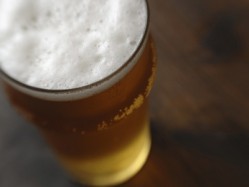Summer drinks trends: Beer

Customers today are becoming more educated on what they want to consume, and pub and bar operators must step up to give them what they want.
This means recognising that drinkers have different tastes according to the occasion, and stocking a wider variety of beers in response.
Variety
“Having a good selection is important for pubs to attract a broader client base,” explains Simon Cox director of the Independent On-Trade at Molson Coors.
“Those that want a pint with their lunch are likely to have different tastes to those drinking on a Friday night, who are likely to have very different preference to families on a Saturday afternoon. If pubs are to thrive they must attract a variety of drinkers.”
Women and price
Any beer offering should also keep in mind the differing tastes of women, who remain the largely untapped consumer group for beer, so stocking some lighter varieties is important. You should also think about stocking some ‘skinny’ or low-calorie options, suggests Leanne Jarrett from the purchasing consortium Beacon.
Price point is also key when thinking about your beer range. Although there is a growing interest in premium brands, don’t ignore the consumers still looking for value for money.
Remember that the people who have cut down on their visits to pubs are those for whom price is a major consideration, so think about ways to attract them back, such as offers of six bottles of beer sold in an ice bucket at a discounted price.
Alcohol content
Another way to capture consumers at that lower price point is to stock beers with a lower alcohol content. A mid-strength beer between 3 and 3.4 per cent will attract less excise duty and so enable bars to sell lagers at a more competitive price compared to standard brands.
But the appeal of mid-strength beers goes beyond their lower price, says nick Holmes from Specialty Brands Development. Specifically, they would suit occasions when consumers are aware of the need to control alcohol intake, for example during a lunch break, before a commute home, or when driving to a country pub.
Upselling
But if you’ll be stocking a broader range of beers, make sure you train your staff accordingly. Customers will often take advice from bar staff, and be willing to open their wallets when they feel the recommendations are worthwhile.
In particular, staff need good knowledge of the lagers they are selling – what they taste like, the gassiness and which food they lend themselves to, says Cox. “This will allow bar tenders to not only improve the experience of the drinker but also up-sell, increasing the pub’s bottom line.”
Also make sure the right glassware is used and the beer is served at its optimum temperature, which is between 5-8 degrees Celsius.
“Ultimately, it is about showing that beer is a respectable drink, with a history and with an abundance of variety – not something to be served out of a grubby glass by someone who isn’t engaged with the customer,” says Cox.
Local and artisan
The most noticeable trend in the beer world – and one that meets all the above criteria – continues to be a move towards local products from microbreweries.
“We will see more and more pubs stocking beers from local producers,” says David Ashton-Hyde, bar manager of Hinds Head in Bray, which recently changed its menu so that all its ales and lagers are from local British breweries.
“These niche producers from our area also try to source local ingredients to make their products, which helps the farming community too. People often refer to their local pub as their ‘local’ and we wanted our beer menu to really reflect that and maintain a community sprit. There is a fantastic array of lager, ale and sprit producers in Britain, and I think more and more pubs will continue to support these businesses.”
Kevin Georgel, Managing Director of Admiral Taverns, adds: “I think the demand chimes with the desire for local-produced goods - products that feel a bit different, not mass market. I think people feel good about supporting small, local businesses, especially when what they’re producing is a hand-crafted product like cask ale.
“Without a doubt, cask ale remains the star of our pubs at Admiral Taverns. We are very lucky to have such an exciting and eclectic brewing industry, with more than 700 different companies making beer in this country. Alongside the big cask ale brands, our licensees are seeing increasing demand for new, diverse, discovery-type ale brands. These are often produced by local breweries, which people seem to feel a real affinity for, and are doing particularly well in community pubs.”
Premium beers from Germany and Belgium also have their place in the market, although the “buzz” in the market right now is around British brewers producing hand crafter styles.
“Whether breaking with or returning to traditions the common denominator seems to be quality, smaller production and buying British,” says Alex Wrethman, owner of Charlotte’s Bistro.
Access more articles in BigHospitality’s Summer Drinks feature here.






















